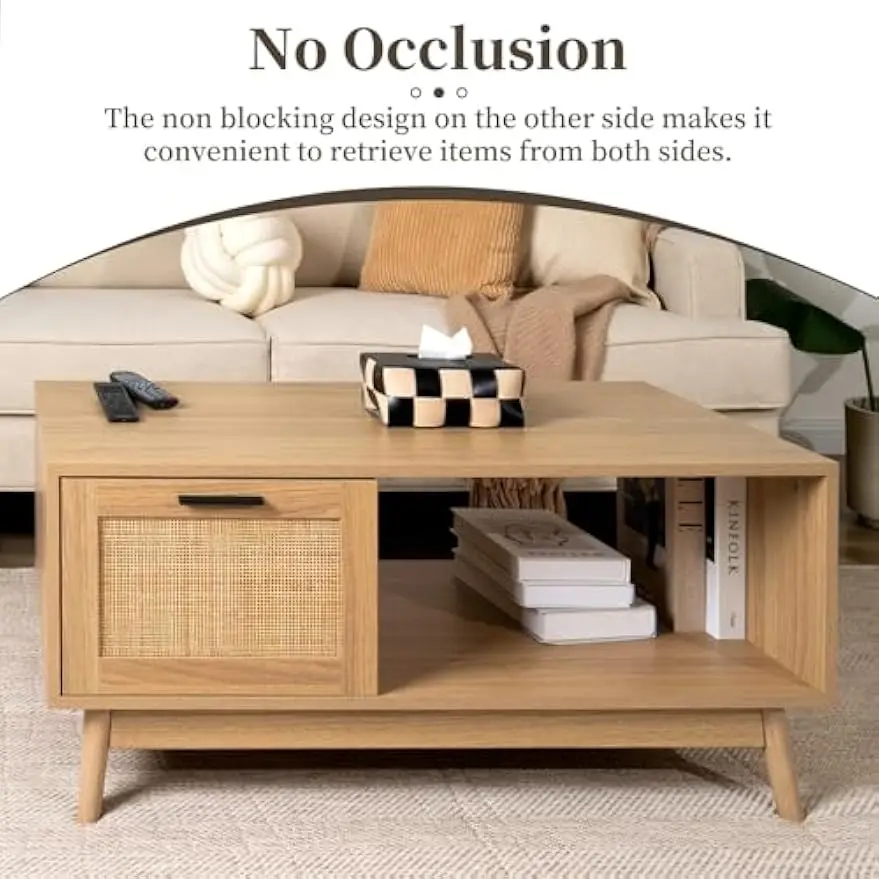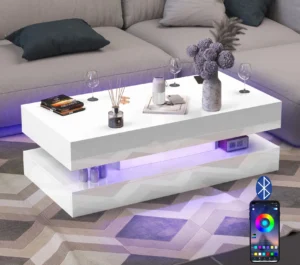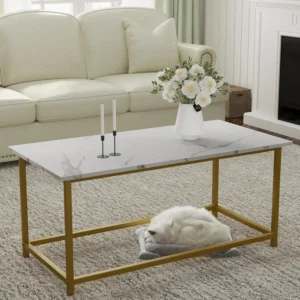Introduction to Large Mid-Century Coffee Tables
Mid-century modern design continues to captivate homeowners with its timeless appeal and functional beauty. This iconic aesthetic, which flourished between the 1940s and 1970s, features clean lines, organic shapes, and a perfect balance of form and function that feels as fresh today as it did decades ago. At the center of many well-designed living spaces sits perhaps the most important furniture piece: the coffee table.
Large mid-century coffee tables serve as both practical surfaces and striking focal points in modern homes. They anchor seating arrangements, provide crucial display space, and establish the design tone for entire rooms. What distinguishes authentic mid-century tables from contemporary imitations includes:
- Emphasis on natural materials, particularly rich hardwoods like walnut and teak
- Thoughtful proportions that honor human scale
- Functional design that serves daily life with elegance
- Meticulous craftsmanship with attention to detail in joinery and finish
As we explore the world of large mid-century coffee tables, we’ll examine five distinctive styles that offer different approaches to this beloved design tradition, each bringing its own character to modern living spaces.
Understanding the Impact of a Large Mid-Century Coffee Table
A substantial coffee table does more than fill space—it creates a strong visual anchor that grounds your entire seating arrangement. In spacious modern homes with open floor plans, a large mid-century coffee table establishes a clear center for your living area, defining the space without using walls or barriers.
The visual weight of these pieces brings balance to rooms with sizable sofas or sectionals. Their proportions feel intentional rather than accidental—a hallmark of thoughtful design. Beyond mere aesthetics, these tables offer generous surface area for entertaining, displaying treasured objects, or simply accommodating daily life activities from casual meals to board games.
The design advantages of large mid-century coffee tables become most apparent when considering how they embody core principles of this design movement: they serve multiple purposes while maintaining clean lines and uncluttered surfaces. The investment quality of these pieces also cannot be overstated—well-crafted mid-century tables often increase in value and appeal over time, making them both functional art and wise purchases.
Our Top 5 Large Mid-Century Coffee Table Styles
When selecting our recommendations, we’ve applied stringent criteria focusing on design authenticity, material quality, and generous proportions. For our purposes, “large” coffee tables typically measure at least 48 inches (122 cm) in length or 42 inches (107 cm) in diameter for round tables, providing ample surface area for both practical use and visual impact.
Each style we’ve highlighted represents a different expression of mid-century design philosophy, allowing you to find the perfect match for your specific aesthetic preferences and functional needs. These tables exemplify the features of large mid-century modern tables that design enthusiasts cherish.
1. Classic Rectangular Walnut Tables with Tapered Legs
Perhaps the most recognizable mid-century coffee table form features clean rectangular lines crafted from rich walnut wood and supported by angled, tapered legs. These iconic pieces typically measure between 54-60 inches (137-152 cm) long and 24-30 inches (61-76 cm) wide, creating a substantial presence without overwhelming the space.
Key characteristics include:
- Solid walnut construction with carefully matched grain patterns
- Splayed legs that angle outward for visual interest and stability
- Slightly rounded edges and corners that soften the geometric form
- Minimal ornamentation that lets the natural wood beauty shine
- Precision joinery, particularly visible in the leg-to-table connections
These versatile tables work beautifully with a range of seating arrangements, from traditional sofa-and-chairs groupings to more contemporary sectional setups. The warm wood tones complement nearly any color scheme, though they pair especially well with neutrals, blues, and earth tones that allow the wood to remain the star.
Our rectangular coffee tables collection showcases this timeless style in various dimensions to suit different spaces.
2. Sculptural Organic-Form Coffee Tables
For those seeking statement pieces that double as functional art, sculptural organic-form tables offer fascinating alternatives to geometric designs. These free-form pieces celebrate natural shapes and flowing lines, often featuring:
- Biomorphic or asymmetrical tabletops that mimic natural forms
- Live-edge wood that preserves the natural contours of the tree
- Solid wood construction showcasing distinctive grain patterns
- Balanced proportions despite their unconventional shapes
- Sculptural bases that complement the artistic tops
These eye-catching tables require careful placement and adequate surrounding space to appreciate their full artistic impact. They work best in settings where they can command attention without competing with too many other bold design elements. Their organic shapes actually create visual harmony by providing a counterpoint to more structured furniture pieces in the room.
When placing such a statement piece, allow 24-30 inches (61-76 cm) of clearance around the table to appreciate its sculptural qualities while maintaining good traffic flow.
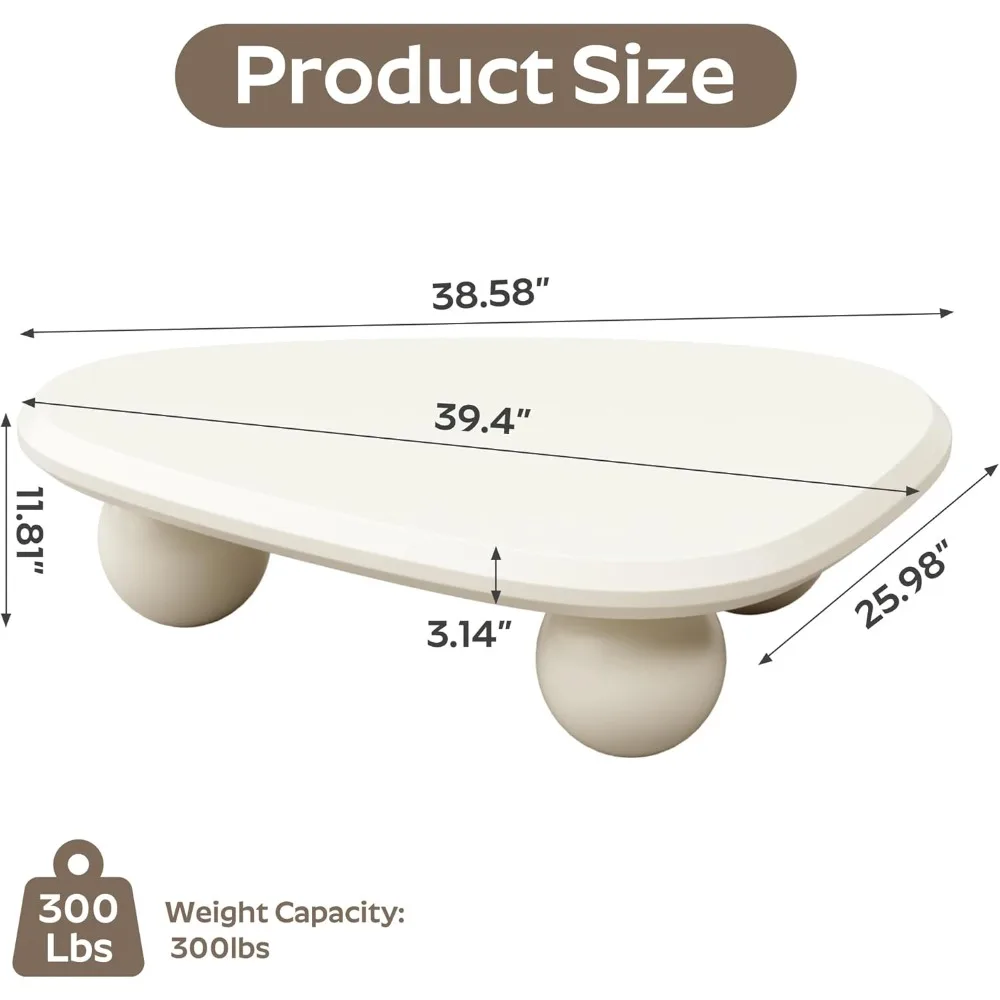
3. Glass-Top Coffee Tables with Sculptural Wooden Bases
For spaces that benefit from visual lightness despite requiring substantial surface area, glass-top coffee tables offer an elegant solution. These sophisticated designs feature:
- Clear, thick tempered glass (typically 1/2 to 3/4 inch thick)
- Artistic wooden or metal bases that become focal points
- Visual lightness that helps smaller spaces feel more open
- Reflective qualities that enhance room lighting
- Dramatic contrast between solid bases and transparent tops
The engineering of these pieces creates fascinating tension between solidity and airiness. Despite their substantial dimensions, these tables allow sight lines to flow through them, reducing visual clutter in the room. The transparent top draws attention to distinctive bases, which often feature sculptural elements like X-shapes, tripod designs, or organic forms.
Our selection of glass top coffee tables showcases various base styles that combine artistic expression with sturdy support for everyday use.
4. Multi-Level and Storage-Focused Coffee Tables
Mid-century designers excelled at combining beauty with practicality, and nowhere is this more evident than in storage-focused coffee table designs. These functional pieces feature:
- Multiple surface levels for display and use flexibility
- Integrated storage drawers that maintain clean lines
- Open shelving for books and larger items
- Strategic compartments for remote controls and small objects
- Thoughtful organization that reduces clutter
The beauty of these designs lies in how seamlessly they integrate storage without sacrificing aesthetic appeal. Many feature offset surfaces at varying heights, creating visual rhythm while providing practical separation of items. The functional uses for large mid-century coffee tables extend beyond simple surface space to comprehensive organization solutions.
These tables work particularly well in smaller living spaces where storage is at a premium, or in homes where the living room serves multiple purposes throughout the day.
5. Round and Oval Large-Format Coffee Tables
Round and oval tables bring a social, conversation-friendly dynamic to living spaces. Their curved edges create natural gathering points and improve traffic flow by eliminating sharp corners. Large circular designs typically feature:
- Diameters of 42-48 inches (107-122 cm) or more
- Pedestal or tulip-style bases that maximize leg room
- Materials ranging from rich woods to marble tops
- Balanced proportions that feel substantial without bulk
- Edges that may be flat, beveled, or feature reveal details
The absence of corners makes these tables particularly well-suited for homes with young children or spaces where people frequently move around the seating area. Their circular form naturally draws people together, creating an inclusive atmosphere perfect for entertaining.
Our collection of round coffee tables offers various diameter options to suit different room sizes while maintaining authentic mid-century design principles.
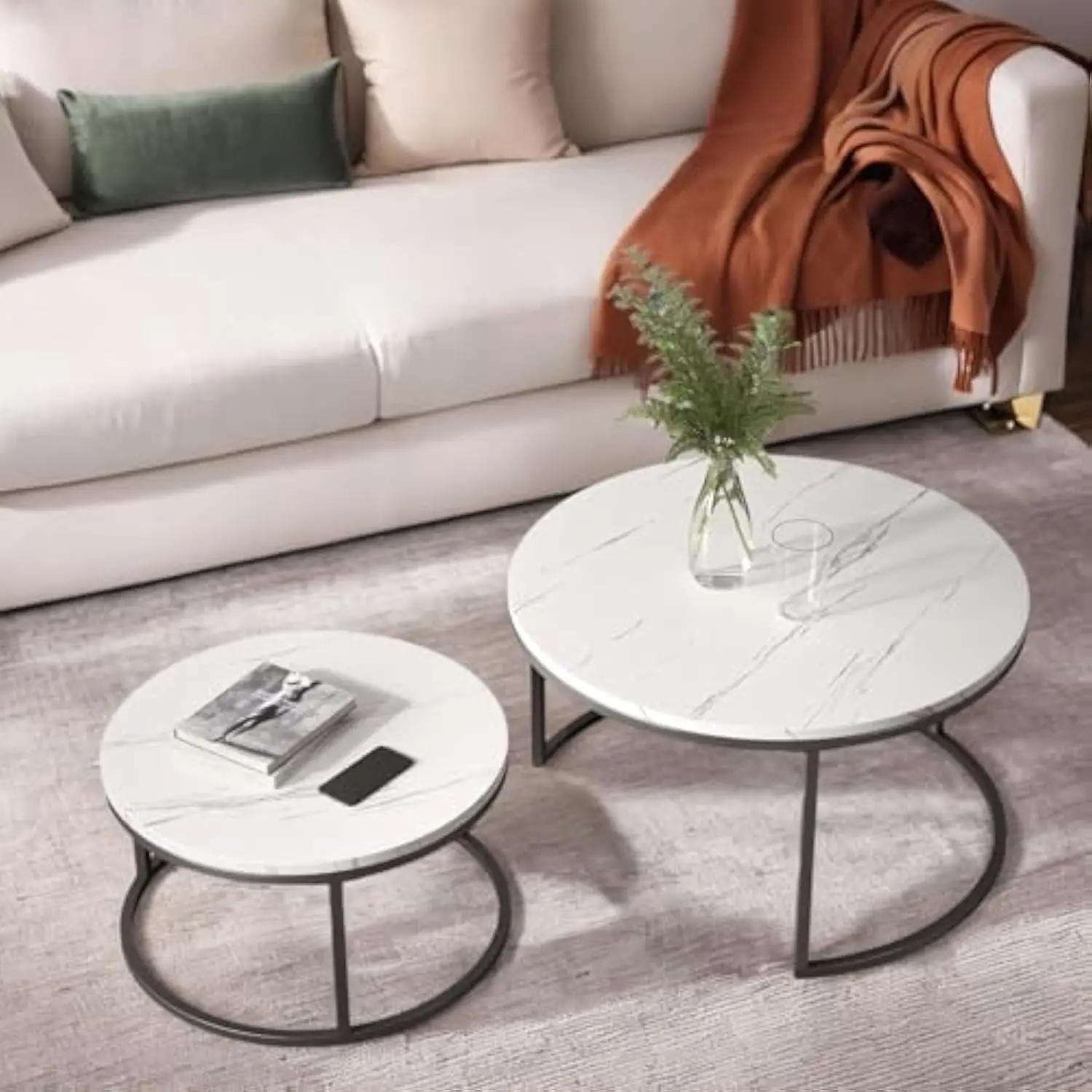
Choosing the Right Size: Proportion Guide for Large Coffee Tables
Finding the perfect size for your coffee table involves more than just measuring your space—it requires understanding proportional relationships between furniture pieces. Follow these guidelines for harmonious results:
- The ideal coffee table length should be approximately two-thirds the length of your sofa
- Height should align with your seating—generally 1-2 inches lower than cushion height
- Allow at least 18 inches (46 cm) clearance between the table and seating for comfortable leg room
- Maintain 30+ inches (76+ cm) for major walkways around the arrangement
- Consider the visual weight—heavier, darker tables require more surrounding space to avoid feeling crowded
For sectionals or extra-large sofas, you might consider either an oversized coffee table or a thoughtful arrangement of multiple tables that work together. The way you arrange your room around a large coffee table significantly impacts both functionality and aesthetic appeal.
In open concept spaces, use your coffee table to help define the living area within the larger room, positioning it centrally within your seating arrangement rather than trying to center it in the overall space.
Material Selection: Finding Quality and Authenticity
The materials used in mid-century coffee tables not only define their appearance but also determine their durability and value. Here’s a comparison of common materials:
| Material | Characteristics | Maintenance | Visual Impact |
|---|---|---|---|
| Solid Walnut | Rich, dark grain patterns; natural warmth | Regular dusting; oil twice yearly; avoid direct sunlight | Substantial, grounding presence |
| Teak | Golden honey tones; natural oils; extremely durable | Minimal maintenance; occasional oil for indoor pieces | Warm, inviting medium visual weight |
| Oak | Distinctive grain; lighter color; very sturdy | Regular dusting; waxing or oiling based on finish | Casual, slightly less formal presence |
| Glass | Transparency; various thicknesses; modern feel | Regular cleaning with non-ammonia glass cleaner; avoid abrasives | Visually light; reflects light; showcases base |
| Brass | Warm metallic glow; develops patina over time | Polishing to maintain shine or allow natural patina | Accent material that adds sophistication |
| Marble | Unique veining; cool surface; natural material | Regular sealing; immediate cleaning of spills; coaster use | Luxurious, substantial presence |
When evaluating quality, look for solid wood construction rather than veneers in wooden components, precision in joinery (how pieces connect), and appropriate weight for the size. Authentic mid-century pieces feature thoughtful details like slight edge beveling, consistent grain matching, and hardware that integrates seamlessly with the design.
Our solid wood coffee tables collection showcases the natural beauty and craftsmanship that defines quality mid-century furniture.
Styling Your Large Mid-Century Coffee Table
A generously sized coffee table provides an excellent canvas for personal expression, but styling requires restraint and intention. Consider these approaches:
- Follow the rule of thirds: divide the table visually into sections rather than cluttering the entire surface
- Create height variation with objects of different scales (books, low vessels, taller sculptural items)
- Include elements that reflect mid-century aesthetic (geometric sculptures, ceramic pieces, art books)
- Incorporate natural elements like wood, stone, or plants that echo mid-century’s connection to nature
- Maintain plenty of negative space—empty areas are as important as the objects you display
The shape of your table should influence your styling approach. Rectangular and round mid-century tables benefit from different arrangement strategies—rectangular tables work well with linear groupings, while round tables favor radial or centered arrangements.
Remember that coffee tables serve practical purposes, so always leave some empty space for drinks, books currently being read, or other items needed during daily use.
Mid-Century Modern Solid Wood Coffee Tables, Mid-Century Modern Teak Coffee Tables
$879.95 Select options This product has multiple variants. The options may be chosen on the product pageMid-Century Modern Danish Coffee Tables, Mid-Century Modern Oval Coffee Tables, Mid-Century Modern Solid Wood Coffee Tables
$390.05 Select options This product has multiple variants. The options may be chosen on the product pageMid-Century Modern Glass Top Coffee Tables, Mid-Century Modern Glass Top Side & End Tables
$460.58 Select options This product has multiple variants. The options may be chosen on the product pageMid-Century Modern Glass Top Coffee Tables, Mid-Century Modern Vintage Coffee Tables, Mid-Century Modern Vintage Side & End Tables
$725.36 Select options This product has multiple variants. The options may be chosen on the product pageMid-Century Modern Large Coffee Tables, Mid-Century Modern Rectangular Coffee Tables
$603.26 Select options This product has multiple variants. The options may be chosen on the product pageMid-Century Modern Marble Top Coffee Tables, Mid-Century Modern Rectangular Coffee Tables, Mid-Century Modern White Coffee Tables
Price range: $163.28 through $189.22 Select options This product has multiple variants. The options may be chosen on the product page
How to Care for Different Mid-Century Table Materials
Proper maintenance ensures your mid-century coffee table remains beautiful for generations:
Solid Wood Care:
– Dust regularly with a soft, slightly damp cloth
– Apply appropriate oil (Danish oil for most mid-century pieces) twice yearly
– Use coasters and placemats to prevent water rings and heat damage
– Maintain consistent indoor humidity to prevent wood expansion/contraction
– Address scratches immediately with appropriate touch-up products
Glass Care:
– Clean with a non-ammonia glass cleaner and lint-free cloth
– Never use abrasive cleaners that could scratch the surface
– Check and tighten any hardware that connects glass to bases periodically
– Use felt pads under any items placed directly on glass
– Consider having a protective coating applied to help resist fingerprints
Metal Component Care:
– Dust regularly with a soft cloth
– Apply appropriate polish based on metal type (brass, stainless steel, etc.)
– Address any oxidation promptly with suitable cleaners
– Check fasteners periodically and tighten if needed
Stone/Marble Care:
– Apply stone sealer every 6-12 months
– Clean spills immediately to prevent staining
– Use coasters for all beverages, especially acidic ones
– Clean with stone-specific products only
– Avoid harsh or acidic cleaners that could etch the surface
Integrating a Large Coffee Table with Other Mid-Century Furniture
Creating a cohesive mid-century inspired space requires thoughtful integration of various pieces. Your large coffee table should:
- Establish a relationship with other wooden elements without exact matching—mid-century homes often featured complementary wood tones rather than identical ones
- Balance with other large pieces in the room through consistent scale and proportion
- Create conversation with accent chairs through complementary design languages
- Connect with side tables that share design elements but don’t duplicate the coffee table
- Harmonize with overall room proportions
The design benefits of round mid-century tables include their ability to soften spaces with too many straight lines, while rectangular tables reinforce architectural elements in the room. Consider your overall space when determining which shape will create the most harmonious effect.
When incorporating other statement pieces, ensure there’s enough visual breathing room between focal points—a large coffee table paired with a dramatic light fixture and bold artwork needs negative space to avoid overwhelming the room.

Frequently Asked Questions About Large Mid-Century Coffee Tables
How can I tell if a coffee table is authentically mid-century in design?
Authentic mid-century design features clean lines, minimal ornamentation, functional forms, and natural materials. Look for tapered legs, organic shapes, and quality craftsmanship with attention to detail in joinery and finish.
What dimensions classify a coffee table as “large”?
Generally, rectangular tables measuring 48 inches (122 cm) or longer, or round tables with diameters of 42+ inches (107+ cm) are considered large, though proportional relationship to your seating is more important than absolute measurements.
Is mixing materials authentic to mid-century design?
Yes! Original mid-century designers frequently combined materials like wood with glass, metal accents, or stone elements. This thoughtful mixing of materials was one of the hallmarks of innovative mid-century design.
How can I verify quality construction in a mid-century coffee table?
Check joinery (how pieces connect), wood grain matching, finish consistency, weight appropriate to size, and smooth operation of any moving parts like drawers. Quality pieces feel solid, with no wobbling or instability.
What’s the best placement for a large coffee table in an open concept living space?
Position your large coffee table within your seating arrangement rather than trying to center it in the overall room. It should anchor your conversation area while allowing comfortable traffic flow around the entire grouping.
Explore our collection of large coffee tables to find pieces that perfectly balance size, style, and craftsmanship for your space.
When to Choose Alternative Table Arrangements Instead
While large coffee tables offer many advantages, sometimes alternative arrangements better suit specific spaces:
- Consider nested tables that can expand when needed and tuck away for space efficiency
- Explore modular tables that can be reconfigured based on changing needs
- Try a cluster of smaller tables that create visual interest through varying heights and materials
- Investigate C-tables or pull-up tables that work with specific seating pieces
- Consider ottoman-table combinations for maximum flexibility in tight spaces
Unusual room layouts might benefit from breaking traditional rules—L-shaped rooms often work better with multiple smaller tables distributed throughout the space rather than one central piece. Similarly, spaces that serve multiple functions may need tables that can easily move or transform.
Why Investing in Quality Mid-Century Design Matters
High-quality mid-century coffee tables represent more than just furniture—they’re investments in enduring design. Unlike trendy pieces that quickly feel dated, authentic mid-century design has already proven its staying power over decades, making it a sound financial and aesthetic choice.
The craftsmanship in premium pieces results in furniture that improves with age rather than deteriorating. Solid wood develops character and patina, quality joints remain stable, and thoughtful design continues to function beautifully regardless of changing trends.
From an environmental perspective, investing in heirloom-quality furniture means fewer replacements over time, reducing waste and resource consumption. The materials used in authentic mid-century pieces—primarily natural woods, metals, and glass—also tend to have lower environmental impacts than the plastics and engineered materials common in lower-quality alternatives.
At Hearth Forms, we believe that surrounding yourself with thoughtfully designed, beautifully crafted furniture enriches daily life in ways that transcend mere function. A quality mid-century coffee table serves as the heart of your living space—a daily reminder that good design brings both practical utility and artistic pleasure to our homes.

